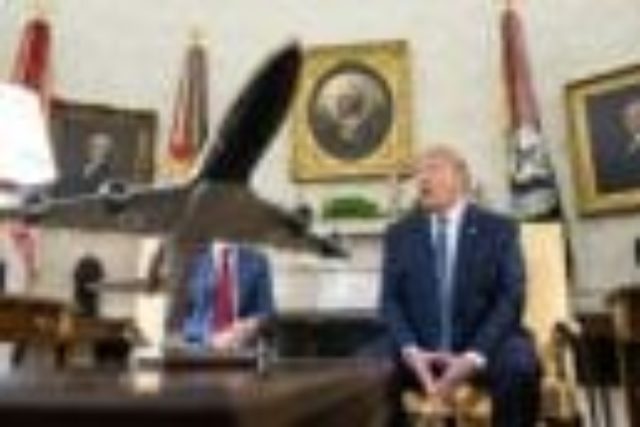
 (Bloomberg) — President Donald Trump said he called off retaliatory strikes on three Iranian sites following the downing of a U.S. Navy drone because the action wouldn’t have been “proportionate.”“We were cocked & loaded to retaliate last night on 3 different sights when I asked, how many will die. 150 people, sir, was the answer from a General,” Trump tweeted Friday. “10 minutes before the strike I stopped it.”A commander in Iran’s Islamic Revolutionary Guard Corps told a semi-official news agency Friday that the drone had been accompanied by a manned U.S. spy plane that Iranian forces decided not to target.The planned U.S. attack, ordered after Iranian forces shot down the pilotless aircraft over the Strait of Hormuz, would have involved airstrikes and was close to being carried out when it was stopped, said an administration official, who wouldn’t discuss whether the plan might be revived. The official was granted anonymity to discuss a national security matter.National Security Advisor John Bolton was pushing for the strike. Officials were prepared to notify allies of the military action, but Trump changed his mind based on additional information, an official said. Iran wasn’t given any warning of possible retaliation. The U.S. notified the U.K. about the aborted action afterward, the official said.With tensions still high, the Iranians called the Swiss ambassador, Markus Leitner, into the Foreign Ministry for talks. The Swiss embassy also represents U.S. interests in Iran, and its envoy traditionally serves as the conduit for messages between the two nations, which have no diplomatic relations. But Brian Hook, the U.S. special representative for Iran, told reporters the Iranians “continue to reject diplomatic overtures to deescalate tensions in the region.”Allies in Europe sought to calm tensions. Andrew Murrison, a U.K. deputy foreign minister, is planning to go to Tehran as soon as possible, a person familiar with the matter said. French President Emmanuel Macron, speaking Friday in Brussels, called for both sides to “avoid escalation,” adding that diplomatic efforts are being made to reach out to Iran for talks.Oil rocketed to its biggest weekly gain in more than two years on the developments. Crude futures rose in New York on Friday and completed a 9.4% rally for the week.Airstrikes would have raised the specter of a far broader conflict in the volatile region, which supplies one-third of the world’s oil. The move and its reversal underscore the wavering approach the president has shown at times regarding military force. He has repeatedly and fiercely lashed out at Iran and North Korea, but then cooled his rhetoric when hostilities threatened to erupt into open conflict. On two occasions since he took office, he has ordered limited military strikes on Syria.In an interview with NBC News on Friday, Trump said the strikes were “about ready to go,” but when he heard that about 150 people would have been killed, he said: “I didn’t think it was proportionate.”In one of his Friday tweets, Trump said “I am in no hurry, our Military is rebuilt, new, and ready to go, by far the best in the world.”Trump spoke Friday with Saudi Arabia’s Crown Prince Mohammad bin Salman to discuss the situation with Iran, stability in the region and the global oil market, the White House said.Iran’s Deputy Foreign Minister for Political Affairs Seyed Abbas Araghchi said the country had “indisputable” evidence the U.S. drone had violated Iranian air space, and state TV showed what it said were recovered parts of the downed aircraft. “The Islamic Republic of Iran would not hesitate for a moment to decisively defend its territory against any aggression,” Araghchi said in a statement released by the Ministry of Foreign Affairs on Friday.One U.S. official insisted there was unanimity among Trump’s advisers on a response. Before the strike was called off, there were discussions Thursday about whether to heighten security and awareness at sensitive domestic sites, another official said.Earlier Thursday, as the attack was being planned, Trump downplayed Iran’s strike on the U.S. Navy drone in the Persian Gulf that escalated regional tensions and fueled a surge in oil prices, suggesting a “loose and stupid” individual may have been responsible for the strike.“I would imagine it was a general or somebody who made a mistake by shooting that drone down,” Trump said during an Oval Office meeting Thursday with Canadian Prime Minister Justin Trudeau. “I find it hard to believe it was intentional. It could have been somebody who was loose and stupid.”The planned U.S. operation was first reported by the New York Times, which said that Trump had pulled back as warplanes were in the air. Two U.S. officials disputed that part of the Times account. Warplanes weren’t en route to the strike when Trump called off the action, though ships and planes already deployed in the region were in position to carry it out, one of the officials said.Trump’s DilemmaThe president is in an increasingly difficult position on Iran. His administration has blamed the Islamic Republic for a series of attacks in the Gulf region since mid-May, including one last week on two oil tankers, but with little consequence for Tehran. He’s shown a desire to project American power, yet during the 2016 election he promised to extricate the U.S. from foreign conflicts, an issue that’s sure to come up as his re-election campaign begins.The U.S. has directed additional forces to the Middle East in recent weeks, but the numbers — about 2,000 troops in total — have been modest and haven’t come with clear indications of where they would be sent or what their mission would be. In some cases, forces already planned for deployment to the region had their arrival accelerated, while troops scheduled to depart saw their tours extended.A military assault by the U.S. could have immediate and far-reaching consequences. With proxy forces or allies in countries including Lebanon, Syria, Iraq and Yemen, among others, retaliation from Iran could come in many forms, targeting not just U.S. interests but Israel as well and raising the risk of disruptions to oil flows out of the wider Persian Gulf region.With Iran “threatening the freedom of navigation in the Strait of Hormuz,” Hook told reporters at a Saudi air base in Kharj, “it’s important that we deny Iran a foothold in the Gulf. It’s very important that we restore deterrence in this region.”During his time in office, Trump has ratcheted up economic sanctions on Iran as part of his “maximum pressure” campaign against the Islamic Republic. Yet he has also said he doesn’t want a war with Tehran and that he is hoping Iran will reach out to negotiate.As tensions climbed on Thursday following the drone strike, regional analysts and lawmakers from both parties warned that the likelihood of a bigger confrontation could be looming, whether intentional or not.Lawmakers Rattled“The president may not intend to go to war here but we’re worried that he and the administration may bumble into a war,” Senate Minority Leader Chuck Schumer, a New York Democrat, told reporters Thursday after a briefing at the White House.The top Republicans in the Senate and House, Mitch McConnell and Kevin McCarthy, called separately for Trump to take a “measured” response to the Iranian actions.Representative Adam Smith, the Washington state Democrat who heads the House Armed Services Committee, said he was part of discussions Thursday at the White House, where the president was “really wrestling” with how to respond.“On the one hand, certainly you want to hold Iran accountable for this. On the other hand, nobody wants this to spin out of control,” Smith said. “He wasn’t sure what the right thing to do was. He was asking his advisers: ‘What do you think?”’In a call with reporters on Friday, House Speaker Nancy Pelosi said she wasn’t informed in advance about the planned strikes. “That would be a departure,” Pelosi said, adding that the president informed her before U.S. military strikes in Syria.Saudi Vice Minister of Defense Khalid bin Salman said he met with Hook, the U.S. envoy, to “explore the latest efforts to counter hostile Iranian acts and continuous escalation that threaten the region’s security and stability.” In a series of posts on Twitter, the minister affirmed Saudi Arabia’s support for the U.S. “maximum pressure campaign on Iran.”The last time the U.S. launched a significant military effort against Iran was Operation Praying Mantis in 1988. In that operation, Navy ships sank two Iranian ships and destroyed two Iranian surveillance platforms.The move came after the USS Samuel B. Roberts was damaged by a mine in the Persian Gulf.Later that year, a U.S. Navy cruiser shot down an Iranian commercial aircraft on a scheduled flight in Iranian airspace, killing nearly 300 people. The U.S. expressed regret for the loss of life and said it mistakenly targeted the plane. Iran said it was a deliberate and illegal act.The U.S. said the Global Hawk drone was flying in international airspace about 34 kilometers (20 miles) from Iranian territory when it was shot down.“This was an unprovoked attack on a U.S. surveillance asset in international airspace,” said Navy Captain Bill Urban, a spokesman for U.S. Central Command.(An earlier version of this story corrected the title for U.K. official Andrew Murrison.)–With assistance from Justin Sink, John Harney and Steven T. Dennis.To contact the reporters on this story: Tony Capaccio in Washington at [email protected];Jennifer Jacobs in Washington at [email protected] contact the editors responsible for this story: Kevin Whitelaw at [email protected], ;Bill Faries at [email protected], Joshua Gallu, Larry LiebertFor more articles like this, please visit us at bloomberg.com©2019 Bloomberg L.P.
(Bloomberg) — President Donald Trump said he called off retaliatory strikes on three Iranian sites following the downing of a U.S. Navy drone because the action wouldn’t have been “proportionate.”“We were cocked & loaded to retaliate last night on 3 different sights when I asked, how many will die. 150 people, sir, was the answer from a General,” Trump tweeted Friday. “10 minutes before the strike I stopped it.”A commander in Iran’s Islamic Revolutionary Guard Corps told a semi-official news agency Friday that the drone had been accompanied by a manned U.S. spy plane that Iranian forces decided not to target.The planned U.S. attack, ordered after Iranian forces shot down the pilotless aircraft over the Strait of Hormuz, would have involved airstrikes and was close to being carried out when it was stopped, said an administration official, who wouldn’t discuss whether the plan might be revived. The official was granted anonymity to discuss a national security matter.National Security Advisor John Bolton was pushing for the strike. Officials were prepared to notify allies of the military action, but Trump changed his mind based on additional information, an official said. Iran wasn’t given any warning of possible retaliation. The U.S. notified the U.K. about the aborted action afterward, the official said.With tensions still high, the Iranians called the Swiss ambassador, Markus Leitner, into the Foreign Ministry for talks. The Swiss embassy also represents U.S. interests in Iran, and its envoy traditionally serves as the conduit for messages between the two nations, which have no diplomatic relations. But Brian Hook, the U.S. special representative for Iran, told reporters the Iranians “continue to reject diplomatic overtures to deescalate tensions in the region.”Allies in Europe sought to calm tensions. Andrew Murrison, a U.K. deputy foreign minister, is planning to go to Tehran as soon as possible, a person familiar with the matter said. French President Emmanuel Macron, speaking Friday in Brussels, called for both sides to “avoid escalation,” adding that diplomatic efforts are being made to reach out to Iran for talks.Oil rocketed to its biggest weekly gain in more than two years on the developments. Crude futures rose in New York on Friday and completed a 9.4% rally for the week.Airstrikes would have raised the specter of a far broader conflict in the volatile region, which supplies one-third of the world’s oil. The move and its reversal underscore the wavering approach the president has shown at times regarding military force. He has repeatedly and fiercely lashed out at Iran and North Korea, but then cooled his rhetoric when hostilities threatened to erupt into open conflict. On two occasions since he took office, he has ordered limited military strikes on Syria.In an interview with NBC News on Friday, Trump said the strikes were “about ready to go,” but when he heard that about 150 people would have been killed, he said: “I didn’t think it was proportionate.”In one of his Friday tweets, Trump said “I am in no hurry, our Military is rebuilt, new, and ready to go, by far the best in the world.”Trump spoke Friday with Saudi Arabia’s Crown Prince Mohammad bin Salman to discuss the situation with Iran, stability in the region and the global oil market, the White House said.Iran’s Deputy Foreign Minister for Political Affairs Seyed Abbas Araghchi said the country had “indisputable” evidence the U.S. drone had violated Iranian air space, and state TV showed what it said were recovered parts of the downed aircraft. “The Islamic Republic of Iran would not hesitate for a moment to decisively defend its territory against any aggression,” Araghchi said in a statement released by the Ministry of Foreign Affairs on Friday.One U.S. official insisted there was unanimity among Trump’s advisers on a response. Before the strike was called off, there were discussions Thursday about whether to heighten security and awareness at sensitive domestic sites, another official said.Earlier Thursday, as the attack was being planned, Trump downplayed Iran’s strike on the U.S. Navy drone in the Persian Gulf that escalated regional tensions and fueled a surge in oil prices, suggesting a “loose and stupid” individual may have been responsible for the strike.“I would imagine it was a general or somebody who made a mistake by shooting that drone down,” Trump said during an Oval Office meeting Thursday with Canadian Prime Minister Justin Trudeau. “I find it hard to believe it was intentional. It could have been somebody who was loose and stupid.”The planned U.S. operation was first reported by the New York Times, which said that Trump had pulled back as warplanes were in the air. Two U.S. officials disputed that part of the Times account. Warplanes weren’t en route to the strike when Trump called off the action, though ships and planes already deployed in the region were in position to carry it out, one of the officials said.Trump’s DilemmaThe president is in an increasingly difficult position on Iran. His administration has blamed the Islamic Republic for a series of attacks in the Gulf region since mid-May, including one last week on two oil tankers, but with little consequence for Tehran. He’s shown a desire to project American power, yet during the 2016 election he promised to extricate the U.S. from foreign conflicts, an issue that’s sure to come up as his re-election campaign begins.The U.S. has directed additional forces to the Middle East in recent weeks, but the numbers — about 2,000 troops in total — have been modest and haven’t come with clear indications of where they would be sent or what their mission would be. In some cases, forces already planned for deployment to the region had their arrival accelerated, while troops scheduled to depart saw their tours extended.A military assault by the U.S. could have immediate and far-reaching consequences. With proxy forces or allies in countries including Lebanon, Syria, Iraq and Yemen, among others, retaliation from Iran could come in many forms, targeting not just U.S. interests but Israel as well and raising the risk of disruptions to oil flows out of the wider Persian Gulf region.With Iran “threatening the freedom of navigation in the Strait of Hormuz,” Hook told reporters at a Saudi air base in Kharj, “it’s important that we deny Iran a foothold in the Gulf. It’s very important that we restore deterrence in this region.”During his time in office, Trump has ratcheted up economic sanctions on Iran as part of his “maximum pressure” campaign against the Islamic Republic. Yet he has also said he doesn’t want a war with Tehran and that he is hoping Iran will reach out to negotiate.As tensions climbed on Thursday following the drone strike, regional analysts and lawmakers from both parties warned that the likelihood of a bigger confrontation could be looming, whether intentional or not.Lawmakers Rattled“The president may not intend to go to war here but we’re worried that he and the administration may bumble into a war,” Senate Minority Leader Chuck Schumer, a New York Democrat, told reporters Thursday after a briefing at the White House.The top Republicans in the Senate and House, Mitch McConnell and Kevin McCarthy, called separately for Trump to take a “measured” response to the Iranian actions.Representative Adam Smith, the Washington state Democrat who heads the House Armed Services Committee, said he was part of discussions Thursday at the White House, where the president was “really wrestling” with how to respond.“On the one hand, certainly you want to hold Iran accountable for this. On the other hand, nobody wants this to spin out of control,” Smith said. “He wasn’t sure what the right thing to do was. He was asking his advisers: ‘What do you think?”’In a call with reporters on Friday, House Speaker Nancy Pelosi said she wasn’t informed in advance about the planned strikes. “That would be a departure,” Pelosi said, adding that the president informed her before U.S. military strikes in Syria.Saudi Vice Minister of Defense Khalid bin Salman said he met with Hook, the U.S. envoy, to “explore the latest efforts to counter hostile Iranian acts and continuous escalation that threaten the region’s security and stability.” In a series of posts on Twitter, the minister affirmed Saudi Arabia’s support for the U.S. “maximum pressure campaign on Iran.”The last time the U.S. launched a significant military effort against Iran was Operation Praying Mantis in 1988. In that operation, Navy ships sank two Iranian ships and destroyed two Iranian surveillance platforms.The move came after the USS Samuel B. Roberts was damaged by a mine in the Persian Gulf.Later that year, a U.S. Navy cruiser shot down an Iranian commercial aircraft on a scheduled flight in Iranian airspace, killing nearly 300 people. The U.S. expressed regret for the loss of life and said it mistakenly targeted the plane. Iran said it was a deliberate and illegal act.The U.S. said the Global Hawk drone was flying in international airspace about 34 kilometers (20 miles) from Iranian territory when it was shot down.“This was an unprovoked attack on a U.S. surveillance asset in international airspace,” said Navy Captain Bill Urban, a spokesman for U.S. Central Command.(An earlier version of this story corrected the title for U.K. official Andrew Murrison.)–With assistance from Justin Sink, John Harney and Steven T. Dennis.To contact the reporters on this story: Tony Capaccio in Washington at [email protected];Jennifer Jacobs in Washington at [email protected] contact the editors responsible for this story: Kevin Whitelaw at [email protected], ;Bill Faries at [email protected], Joshua Gallu, Larry LiebertFor more articles like this, please visit us at bloomberg.com©2019 Bloomberg L.P.








